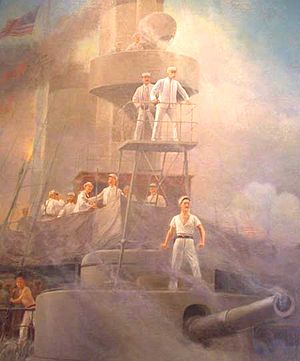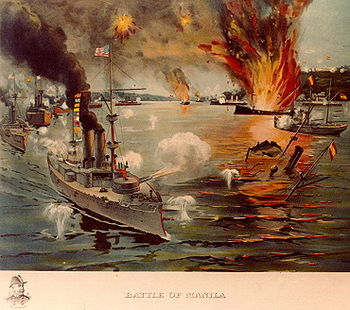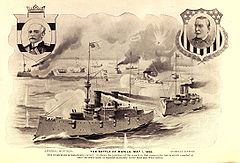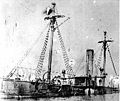- Battle of Manila Bay
-
Battle of Manila Bay Part of the Spanish-American War 
Commodore George Dewey aboard the cruiser Olympia.Date 1 May 1898 Location Near Manila, Philippines Result Decisive U.S. victory Belligerents  United States
United States Kingdom of Spain
Kingdom of SpainCommanders and leaders  George Dewey
George Dewey Patricio Montojo y Pasarón
Patricio Montojo y PasarónStrength Engaged Forces:[cn 1]
4 protected cruisers
2 gunboats
Unengaged Forces:
1 revenue cutter
2 transportsEngaged Forces:[cn 1]
2 protected cruisers
4 unprotected cruisers
2 gunboats
Unengaged Forces:
1 cruiser
3 gunboats,
1 transport
Shore defenses
6 batteries
3 fortsCasualties and losses 1 dead (due to heatstroke),[5]
9 wounded,
1 protected cruiser damaged161 dead,
210 wounded,
2 protected cruisers sunk,
5 unprotected cruisers sunk,
1 transport sunkPacific Theater: Spanish American WarThe Battle of Manila Bay took place on 1 May 1898, during the Spanish-American War. The American Asiatic Squadron under Commodore George Dewey engaged and destroyed the Spanish Pacific Squadron under Admiral Patricio Montojo y Pasarón. The engagement took place in Manila Bay in the Philippines, and was the first major engagement of the Spanish-American War.
Contents
Prelude
Admiral Montojo, who had been dispatched rapidly to the Philippines, was equipped with a variety of obsolete vessels. Efforts to strengthen his position amounted to little. The Spanish bureaucracy knew they could not win a war and saw resistance as little more than a face-saving exercise. Administration actions worked against the effort, sending explosives meant for naval mines to civilian construction companies while the Spanish fleet in Manila was seriously undermanned by inexperienced sailors who had not received any training for over a year.[6] Reinforcements promised from Madrid resulted in only two poorly-armored scout cruisers being sent while at the same time the authorities transferred a squadron from the Manila fleet under Admiral Pascual Cervera to reinforce the Caribbean. Montojo compounded his difficulties by placing his ships outside the range of Spanish coastal artillery (which might have evened the odds) and choosing a relatively shallow anchorage. His intent seems to have been to spare Manila from bombardment and to allow any survivors of his fleet to swim to safety. The harbor was protected by six shore batteries and three forts whose fire during the battle proved to be ineffective. Only Fort San Antonio Abad had guns with enough range to reach the American fleet, but Dewey never came within their range during the battle.[3][6]
Battle
 USS Olympia entering Manila Bay.
USS Olympia entering Manila Bay.
At 7 p.m. on 30 April, Montojo was informed that Dewey's ships had been seen in Subic Bay that morning. As Manila Bay was considered unnavigable at night by foreigners, Montojo expected an attack the following morning. The American Consul in Manila, however, had provided Dewey with detailed information on the state of the Spanish defenses and the lack of preparedness of the Spanish fleet, prompting him to enter the bay immediately. At midnight Dewey, aboard the protected cruiser USS Olympia, led his squadron into Manila Bay. Passing the entrance, two Spanish mines exploded but were ineffective as they were well below the draft of any of the ships due to the depth of the water. Inside the bay, ships normally used the north channel between Corregidor Island and the northern coast and this was the only channel mined. Dewey instead used the unmined south channel between El Fraile and Caballo Islands. The El Fraile battery fired a few rounds but the range was too great. The McCulloch, Nanshan and Zafiro were now detached from the line and took no further part in the fighting. At 5:15 a.m. on 1 May, the squadron was off Manila and the Cavite battery fired ranging shots. The shore batteries and Spanish fleet then opened fire but all the shells fell short as the fleet was still out of range.[6] At 5:41 with the now famous phrase, "You may fire when ready, Gridley,"[1] the Olympia's captain was instructed to begin the destruction of the Spanish flotilla.[7]
The U.S. squadron swung in front of the Spanish ships and forts in line ahead, firing their port guns. They then turned and passed back, firing their starboard guns. This process was repeated five times, each time closing the range from 5,000 yards to 2,000 yards. The Spanish forces had been alerted, and most were ready for action, but they were heavily outgunned. Eight Spanish ships, the land batteries, and the forts returned fire for two and a half hours although the range was too great for the guns on shore. Five other small Spanish ships were not engaged.
Montojo accepted that his cause was hopeless and ordered his ships to ram the enemy if possible. He then slipped the Cristina’s cables and charged. Much of the American fleet's fire was then directed at her and she was shot to pieces. Of the crew of 400, more than 200, including Montojo, were casualties and only two men remained who were able to man her guns. The ship managed to return to shore and Montojo ordered it to be scuttled. The Castilla, which only had guns on the port side, had her forward cable shot away causing her to swing about, presenting her weaponless starboard side. The captain then ordered her sunk and abandoned. The Ulloa was hit by a shell at the waterline that killed her captain and disabled half the crew. The Luzon had three guns out of action but was otherwise unharmed. The Duero lost an engine and had only one gun left able to fire.[6]
 Contemporary colored print, showing USS Olympia in the left foreground, leading the U.S. Asiatic Squadron in destroying the Spanish fleet off Cavite. A vignette portrait of Rear Admiral George Dewey is featured in the lower left.
Contemporary colored print, showing USS Olympia in the left foreground, leading the U.S. Asiatic Squadron in destroying the Spanish fleet off Cavite. A vignette portrait of Rear Admiral George Dewey is featured in the lower left.
At 7:45 a.m., after Captain Gridley messaged Dewey that only 15 rounds of 5" ammunition remained per gun, he ordered an immediate withdrawal. To preserve morale, he informed the crews that the halt in the battle was to allow the crews to have breakfast.[7] According to an observer on the Olympia, At least three of his (Spanish) ships had broken into flames but so had one of ours. These fires had all been put out without apparent injury to the ships. Generally speaking, nothing of great importance had occurred to show that we had seriously injured any Spanish vessel. Montojo took the opportunity to now move his remaining ships into Bacoor Bay where they were ordered to resist for as long as possible.[6]
A captains' conference on the Olympia revealed little damage and no men killed. It was discovered that the original ammunition message had been garbled - instead of only 15 rounds of ammunition per gun remaining, the message had meant to say only 15 rounds of ammunition per gun had been expended. During the conference reports arrived that sounds of exploding ammunition had been heard and fires sighted on the Cristina and Castilla. At 10:40 AM action was resumed but the Spanish offered little resistance and Montojo issued orders for the remaining ships to be scuttled and the breechblocks of their guns taken ashore. The Olympia, Baltimore and Boston then fired on the Sangley Point battery putting it out of action and followed up by sinking the Ulloa. The Concord fired on the transport Mindanao, whose crew immediately abandoned ship. The Petrel fired on the government offices next to the arsenal and a white flag was raised over the building after which all firing ceased.[6] The Spanish colors were struck at 12:40 PM.
The results were decisive. Dewey won the battle[7] with seven men very slightly wounded,[8] a total of nine injured, and only a single fatality among his crew: Francis B. Randall, Chief Engineer on the McCulloch, from a heart attack.[9]
Subsequent action
A Spanish attempt to attack Dewey with the naval task force known as Camara's Flying Relief Column came to naught, and the naval war in the Philippines devolved into a series of torpedo boat hit-and-run attacks for the rest of the campaign. While the Spanish scored several hits there were no American fatalities directly attributable to Spanish gunfire.
On 2 May, Dewey landed a force of Marines at Cavite. They completed the destruction of the Spanish fleet and batteries and established a guard for the protection of the Spanish hospitals. The resistance of the forts was weak. The Olympia turned a few guns on the Cavite arsenal, detonating its magazine, and ending the fire from the Spanish batteries.
Aftermath
In recognition of George Dewey's leadership during the Battle of Manila Bay a special medal known as the Dewey Medal was presented to the officers and sailors under Admiral Dewey's command. Dewey was later honored with promotion to the special rank of Admiral of the Navy; a rank that no one has held before or since in the United States Navy. Building on his popularity, Dewey briefly ran for president in 1900, but withdrew and endorsed William McKinley, the incumbent, who won.
Dewey's flagship, the Olympia, is preserved as a museum ship in Philadelphia, Pennsylvania, at the Independence Seaport Museum (formerly the Philadelphia Maritime Museum).
Order of battle
United States
Engaged Vessels:
- USS Olympia, flagship, protected cruiser of 5,870 tons. Twin 8-inch guns mounted in turrets fore and aft, ten 5-inch guns and six torpedo tubes. Top speed 20 knots.
- USS Baltimore, protected cruiser of 4,600 tons. Single 8-inch guns mounted fore and aft, two 8-inch and two 6-inch guns aiming axially and three 6-inch guns aiming on each broadside. Top speed 20 knots.
- USS Raleigh, protected cruiser of 3,200 tons. One 6-inch and two 5-inch guns aiming forward, four 5-inch guns aiming astern and two 5-inch guns aiming on each broadside. Top speed 19 knots.
- USS Boston, protected cruiser of 3,200 tons. Single 8-inch guns mounted in barbettes fore and aft with 6-inch axial firing guns mounted beside each. Four additional 6-inch guns. Top speed 13 knots.
- USS Concord, gunboat of 1,710 tons with six 6-inch guns. Top speed 17 knots.
- USS Petrel, gunboat of 867 tons with four 6-inch guns. Top speed 12 knots.
Unengaged Vessels:
- The Revenue Cutter McCulloch, the collier Nanshan and the steamer Zafiro (a supply vessel) were directed to keep out of the main action because of their light armament and lack of armor. The McCulloch's chief engineer died of a heart attack.[9]
Spain
Engaged Vessels:
- Reina Cristina, flagship, unprotected cruiser of 3,042 tons, with six 6.4-inch guns. The fastest Spanish vessel with a top speed of 16 knots.
- Castilla, unprotected cruiser of 3,289 tons, with four 5.9-inch and two 4.7-inch guns. The vessel's 8-inch guns had been removed to equip the shore batteries. The ship was used as a floating battery as the temporary repair of the leaks had immobilized her propeller shaft.
- Don Antonio de Ulloa, unprotected cruiser of 1,152 tons, with two 4.7-inch guns on the starboard side. Under repair with her engines ashore. Her entire port side armament had been removed to equip the shore batteries.
- Don Juan de Austria, unprotected cruiser of 1,152 tons, with four 4.7-inch guns. Top speed 13 knots.
- Isla de Cuba, protected cruiser of 1,030 tons, with six 4.7-inch guns. Top speed 14 knots.
- Isla de Luzón, protected cruiser of 1,030 tons, with six 4.7-inch guns. Top speed 14 knots.
- Marques del Duero, gunboat of 492 tons, with one 6.4-inch and two 4.7-inch guns. Top speed 10 knots.
Engaged vessels ranged in size from 5870 tons (Olympia) to 492 tons (Marques del Duero).[2]
Unengaged Vessels:
- Mindanao, transport ship of 1,900 tons, with 2 secondary rapid fire guns. 77 men.
- Velasco, unprotected cruiser of 1152 tons. Her boilers were ashore being repaired. All her guns were apparently removed to the Caballo Island Battery. 145 men.
- El Coreo, gunboat of 560 tons, with three 4.7-inch guns, three secondary rapid fire guns, and 1 torpedo tube. 115 men.
- General Lezo, gunboat of 520 tons, with two 4.7-inch guns which were apparently removed to El Fraile Island, 2 secondary rapid fire guns, and 1 torpedo tube. 115 men.
- Argos, gunboat of 508 tons, with one 3.5-inch gun. 87 men.
The Spanish vessels had 19 torpedo tubes between them but no serviceable torpedoes.
Shore Defenses
- Fort San Antonio Abad: Built 1584. Located in Manila. Various guns with only the 9.4-inch having enough range to reach Dewey's ships at their closest approach.
- Fort San Felipe: Built 1609. A small castle built on a sandbar protected by a breakwater and separated from Cavite City by a moat.
- Cavite Fort: Fortified naval base and shipyard in Cavite City located adjacent to Fort San Felipe.
- Corregidor battery: Entrance to Manila Bay. Did not fire.
- Caballo battery: Entrance to Manila Bay. Did not fire.
- El Fraile battery: Entrance to Manila Bay. Fired three rounds before Raleigh silenced it after hitting the battery with a single shell.
- Cañacao battery: Located in the town of Cañacao. Armed with a single 4.7-inch gun. Did not fire.
- Sangley Point battery: Located at the Sangley Point Naval Base. Armed with three 64-lb muzzleloading cannon and two 5.9-inch guns (which were the only ones to fire.)
- Malate battery: Located in the Manila district of Malate. Did not fire.
The batteries were supplemented with the guns removed from Montojo's fleet. The Corregidore, Caballo and El Fraile batteries had a combined total of 17 guns.
 Engraving of the Battle of Manila Bay with portraits of the respective commanders, from The history and conquest of the Philippines and our other island possessions; embracing our war with the Filipinos by Alden March, 1899.
Engraving of the Battle of Manila Bay with portraits of the respective commanders, from The history and conquest of the Philippines and our other island possessions; embracing our war with the Filipinos by Alden March, 1899.
Multiple dispatches were exchanged between Dewey and John D. Long, Secretary of the Navy, immediately prior to, and following, the Naval Battle of Manila Bay. One dispatch notified Dewey of his promotion to the acting grade of Rear Admiral:[10]
HONGKONG, May 7, 1898. (Manila, May 1.)
SECRETARY OF THE NAVY, Washington:
The squadron arrived a Manila at daybreak this morning. Immediately engaged enemy and destroyed the following Spanish vessels: Reina Christina, Castilla, Don Antonio de Biloa, Don Juan de Austria, Isla de Luzon, Isla de Cuba, General Lezo, Marquis del Duaro, El Curreo, Velasco, one transport, Isla de Mandano, water battery at Cavite. I shall destroy Cavite arsenal dispensatory. The squadron is uninjured. Few men were slightly wounded. I request the Department will send immediately from San Francisco fast steamer with ammunition. The only means of telegraphing is to the American consul at Hongkong.
DEWEY.HONGKONG, May 7, 1898. (Cavite, May 4.)
SECRETARY OF THE NAVY, Washington:
I have taken possession of the naval station at Cavite, Philippine Islands, and destroyed its fortifications. Have destroyed fortifications bay entrance, paroling garrison. Have cut cable to main land. I control bay completely and can take city at any time, but I have not sufficient men to hold. The squadron excellent health and spirits. The Spanish loss not fully known; very heavy; 150 killed, including captain, on Reina Cristina, alone. I am assisting and protecting Spanish sick and wounded, 250 in number, in this hospital, within our lines. Will ammunition be sent? I request answer without delay. I can supply squadron coal and provisions for a long period. Much excitement at Manila. Scarcity of provisions on account of not having economized stores. Will protect foreign residents.
DEWEY.WASHINGTON, May 7, 1898.
DEWEY (care American consul), Hongkong:
The President, in the name of the American people, thanks you and your officers and men for your splendid achievement and overwhelming victory. In recognition he has appointed you acting rear admiral, and will recommend a vote of thanks to you by Congress as a foundation for further promotion. The Charleston will leave at once with what ammunition she can carry. Pacific Mail Steamship Company steamer Pekin will follow with ammunition and supplies. Will take troops unless you telegraph otherwise. How many will you require? LONG.Gallery
See also
- Battle of Manila
- Battles of the Spanish-American War
- Spanish-American War
- Philippine-American War
Notes
- ^ a b Accounts of the numbers of vessels involved vary. Admiral Dewey said, "The Spanish line of battle was formed by the Reina Cristina (flag), Castilla, Don Juan de Austria, Don Antonio de Ulloa, Isla de Luzon, Isla de Cuba, and Marques del Duero."[1] Another source lists the order of battle as consisting of nine US ships (two not engaged) and 13 Spanish ships (five not engaged and one not present).[2] Still another source says that the Spanish naval force consisted of seven unarmored ships.[3] Yet another source says that the Dewey's squadron included four cruisers (two armored), two gunboats, and one revenue cutter; and that the Spanish fleet consisted of one modern cruiser half the size of Dewey's Olympia, one old wooden cruiser, and five gunboats.[4]
References
- ^ a b According to an article titled The Battle of Manila Bay, written by Admiral Dewey for the War Times Journal, his actual words were, "You may fire when you are ready, Gridley.
- ^ a b The Battle of Manila Bay by Patrick McSherry, from spanamwar.com. Retrieved on 10 October 2007
- ^ Symonds, Craig L.; Clipson, William J. (2001). The Naval Institute historical atlas of the U.S. Navy. Naval Institute Press. p. 110. ISBN 9781557509840. http://books.google.com/books?id=q_HIcc8n3K4C.
- ^ Brinkley, Alan (1995). American History: A Survey. McGraw-Hill. ISBN 0079121144.
- ^ a b c d e f Koenig, William (1975). Epic Sea Battles. Page 102-119: Peerage Books. ISBN 0907408435.
- ^ a b c The Battle of Manila Bay by Admiral George Dewey, The War Times Journal. Retrieved on 10 October 2007
- ^ Admiral Dewey's Report on the Battle of Manila Bay, spanamwar.com, Retrieved on 9 February 2011.
- ^ a b Patrick McSherry, The Battle of Manila Bay (Cavite), May 1, 1898, spanamwar.com, Retrieved on 9 February 2011.
- ^ Dispatches exchanged between Admiral George Dewey and John D. Long, Secretary of the Navy (archived from Dispatches the original on 21 November 2007), Department of the Navy - Naval Historical Center. Retrieved on 10 October 2007
Additional References
- Nofi, Albert A., The Spanish American War, 1898, 1997.
- Carrasco García, Antonio, En Guerra con Los Estados Unidos: Cuba, 1898, Madrid: 1998.
- Freidel, Frank Burt. The Splendid Little War. Boston: Little, Brown,1958.
- Blow, Michael. A Ship to Remember: The Maine and the Spanish-American War. New York : Morrow, 1992. ISBN 0-688-09714-6.
External links
- Spanish-American War Centennial Website
- 1898 Battle of Manila Bay (archived from the original on 2009-10-26)
Coordinates: 14°30′N 120°45′E / 14.5°N 120.75°ECategories:- Naval battles of the Spanish–American War
- Conflicts in 1898
- Philippine–American War
- History of Manila
- United States Marine Corps in the 18th and 19th centuries
Wikimedia Foundation. 2010.








